|
|

At the time of the Restoration the St George's Cross covered the whole Colour instead of being confined to the top corner. The senior company Colour, or King's Colour in the case of the Guards, was of the colonel's colour, (plain crimson for the Guards, later adding the crown and cypher). Under William III the line regiments had their Colours restricted at first, to the three field officers, later just the colonel and lieut-col. But the Guards continued with a Colour for each company. In 1707 the Union Flag replaced the cross of St George.
There were new regulations in 1747 which ruled that each line regiment or battalion should have two Colours without any personal devices of the colonel. The King's Colour was to be the Union Flag and the Regimental Colour was to have a small union flag in the upper canton, the rest of the flag being in the facing colour with either the number of the regiment in the middle, or a badge. The Guards have traditionally differed from the line regiments in that the former field officers' Colours were the King's Colours for each battalion, and the Regimental Colour was one of the Company Colours used in rotation.
Company Colours
The Coldstream Guards were not issued with Company Colours until 1750 whereas the 1st Guards were granted theirs by Charles II. Their strength was half that of the 1st Guards so consequently their Company Colours were fewer. By the early 19th Century there were 16 Companies with colours based on the Union Flag but displaying the following Company badges
| 1st Company | Silver Lion sejant guardant (seated with paws up), on green mount |
| 2nd | Prince of Wales's Feathers |
| 3rd | Silver Panther spotted in colours, flames from mouth and ears |
| 4th | Crossed swords with gold hilts and pommels |
| 5th | St George slaying dragon |
| 6th | Red rose within garter |
| 7th | Centaur on green mount |
| 8th | Crossed Golden sceptres |
| 9th | Golden knot from collar of garter |
| 10th | Escarbuncle of gold* |
| 11th | Silver boar passant (standing) with golden bristles, on green mount |
| 12th | Dun cow on green mount |
| 13th | Union Rose impaled with golden pomegranate, green leaves and stalk |
| 14th | Silver Horse courant (running), on green mount |
| 15th | Golden 'Charlemain' crown |
| 16th | The Brunswick crest** |
**Out of a ducal coronet a pillar, the top adorned with a coronet and plume of 3 peacock feathers charged with a silver star on either side of the pillar. Out of the coronet a silver sickle with red handles, the backs adorned with small tufts of peacock feathers. Between the sickles before the pillar, a running horse in silver.
A further eight companies were granted badges in 1901 by Queen Victoria.
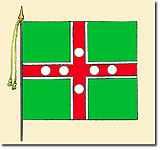 |
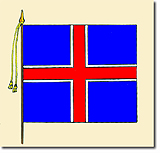 |
|
| Sixth Captain's Colour 1669 | Colour 1680 | |
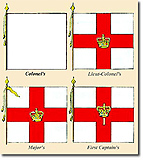 |
||
| Colours 1685 | ||
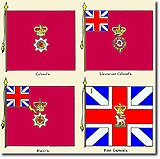 |
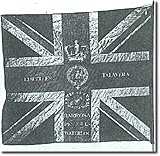 |
|
| Colours 1750 | 6th Company Colour c1820 | |
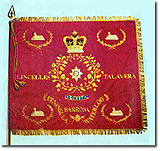 |
||
| State Colour c1830 |
Armed Forces | Art and Culture | Articles | Biographies | Colonies | Discussion | Glossary | Home | Library | Links | Map Room | Sources and Media | Science and Technology | Search | Student Zone | Timelines | TV & Film | Wargames